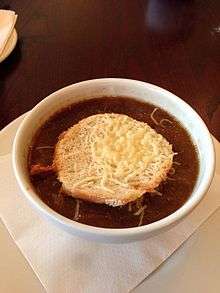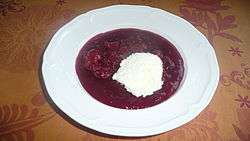List of German soups
This is a list of German soups. German cuisine has evolved as a national cuisine through centuries of social and political change with variations from region to region. In Germany, soups are a popular and significant food, and many Germans eat soup at least once a week.[1] In German cuisine, it may be served as a first course or as a main course.[1] The use of a roux to thicken soups is common in German cuisine.[2] The use of legumes and lentils is significant and used in several German soups, such as split pea soup.[2] Common soups in German restaurants include oxtail, beef or chicken broth with noodles, dumplings, or rice, goulash, split pea, cream of asparagus, turtle soup (Echte Schildkrötensuppe) and cream of lobster.[1]
In the 1880s, Germans had an appreciation for soups prepared with beer as a primary ingredient, which was prepared with beer with a lesser alcohol content compared to standard beers.[3] One recipe utilized beer, water, sugar, raisins, spices and grated, stale bread.[3]
This list includes soups that originated in Germany as well as those that are common in the country.
German soups
| Name | Image | Type | Description |
|---|---|---|---|
| Beer soup [4] |  |
Soup | In medieval Europe, it was served as a breakfast soup,[5] sometimes poured over bread. Pictured is beer cheese soup. |
| Brain soup [3] | Soup | ||
| Bread soup [3] |  |
Soup | |
| Beetenbartsch |  |
Soup | A beetroot-based soup served with sour cream (schmand) and beef (originally from Russia) |
| Buttermilchsuppe | Soup | Buttermilk soup with flour dumplings | |
| Cheese soup [3] | Soup | All through the middle ages, soup prepared from cheese, eggs and pepper was commonly served in German monasteries.[3] Pictured is a cheese and potato soup. | |
| Crawfish soup [3] | Soup | ||
| Fliederbeersuppe | Dessert | Dessert soup made from elderberry, served with semolina dumplings | |
| French onion soup [1] |  |
Soup | A very common soup in German cuisine.[1] |
| Fruit soup [3] |  |
Soup | Cherry soup (pictured) has been described as a seemingly popular soup in Germany.[3] |
| Goulash [1] | Soup or stew | Pictured is Bavarian Gulash mit Semmelknödel which is often made with a mix of beef and pork. Here it is served with a Semmelknödel, a bread dumpling. | |
| Gemüsesuppe (a kind of Eintopf) |  |
Soup | A simple vegetable soup; small meat balls are optional but common in it. |
| Grumbeersupp un Quetschekuche |  |
Main course | Potato soup and plum tart |
| Hamburger Aalsuppe (Hamburg Eel Soup) [6] | Soup | A sweet and sour soup of eel, meat broth, dried fruits, vegetables, and herbs | |
| Hochzeitssuppe (literally "wedding soup") | .jpg) |
Soup | A spicy meat broth with bread dumplings, liver dumplings and finely sliced pancakes |
| Kartoffelsuppe |  |
Soup or stew | A stew made with raw potatoes and other ingredients such as vegetables and sausage |
| Königsberger Fleck | Soup | A type of Kuttelsuppe, or tripe soup | |
| Lentil soup |  |
Soup | Prepared throughout the year in Germany, in part because the dry lentils store well.[2] Pictured is yellow Lentil soup with melted butter and fried onions. |
| Milk soup [3] | Soup | Consumed with semolina by Germans in the 1880s.[3] | |
| Noodle soups [3] | Soup | Noodle soups include those with or without chicken and liver noodle soup[3] | |
| Nudelsuppe [3] | .jpg) |
Soup | Strong chicken stock and noodles[3] |
| Potato soup [2] |  |
Soup | A common soup throughout Germany.[2] |
| Rumford's Soup |  |
Soup | A simple soup prepared with barley or barley meal and dried peas as primary ingredients that was utilized in Munich and greater Bavaria to feed impoverished people.[7] |
| Schälklöße | Soup | Consists of filled pasta and various vegetables | |
| Schwarzsauer [8] | Soup | A type of pork blood soup with various spices cooked in vinegar-water.[8] A sort of black pudding made with vinegar. The dish originated in eastern Prussia.[8] |
In culture
The German tale of Suppenkasper involves "a little boy who faded away because he refused to eat his soup".[1]
See also
References
| Wikimedia Commons has media related to Soups of Germany. |
- 1 2 3 4 5 6 7 Sheraton, M. (2010). The German Cookbook: A Complete Guide to Mastering Authentic German Cooking. Random House Publishing Group. p. 79. ISBN 978-0-307-75457-8. Retrieved January 25, 2015.
- 1 2 3 4 5 Heberle, M.O. (1996). German Cooking. HPBooks. p. 56. ISBN 978-1-55788-251-6. Retrieved January 25, 2015.
- 1 2 3 4 5 6 7 8 9 10 11 12 13 14 15 Rumble, V.R. (2009). Soup Through the Ages: A Culinary History with Period Recipes. McFarland, Incorporated Publishers. pp. 77–78. ISBN 978-0-7864-5390-0. Retrieved January 25, 2015.
- ↑ Smith, H. (2008). The Master Books of Soups. Cooking in America Series. Applewood Books. p. 176. ISBN 978-1-4290-1180-8. Retrieved January 25, 2015.
- ↑ 1,001 Foods to Die For - Andrews McMeel Publishing, Madison Books - Google Books
- ↑ Sheraton, M. (2010). The German Cookbook: A Complete Guide to Mastering Authentic German Cooking. Random House Publishing Group. p. 105. ISBN 978-0-307-75457-8. Retrieved January 25, 2015.
- ↑ Kellogg, D.O.; Baynes, T.S.; Smith, W.R. (1903). The Encyclopædia Britannica: New American supplement. A-ZUY. The Encyclopædia Britannica: A Dictionary of Arts, Sciences, and General Literature. Original 9th Ed. in 25 Vols. Werner. p. 673. Retrieved January 24, 2015.
- 1 2 3 Chaffey, D. (2010). Dirty German. Dirty Everyday Slang Series. Ulysses Press. p. 272. ISBN 978-1-56975-850-2. Retrieved January 25, 2015.